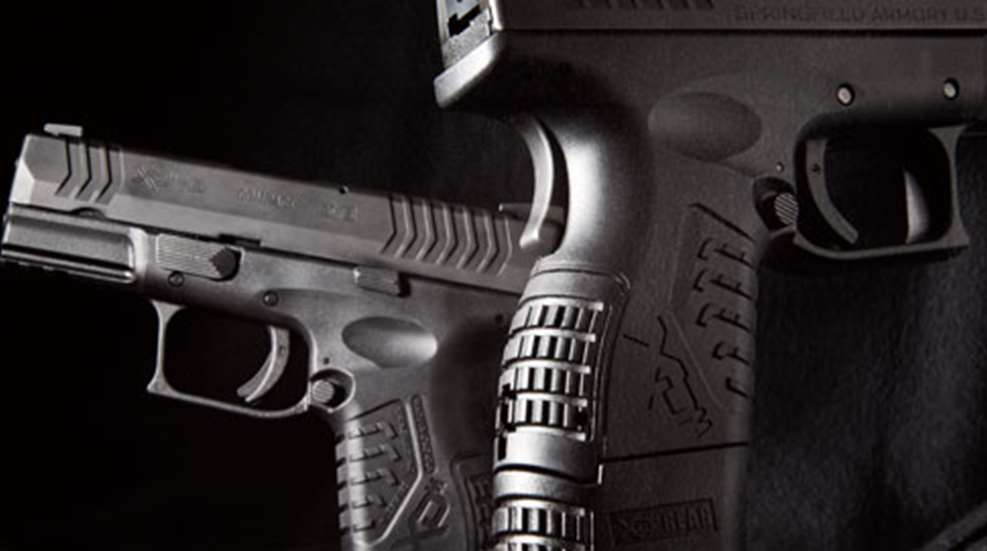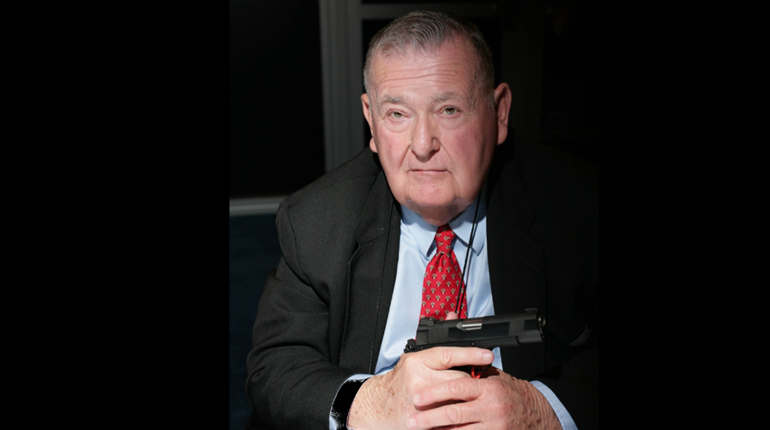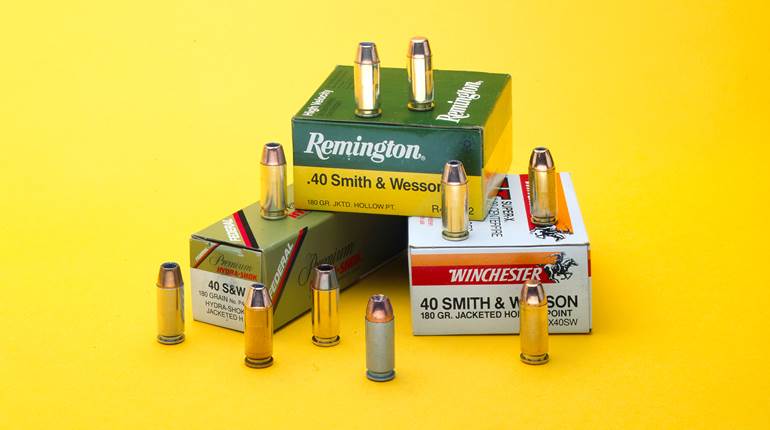
For every handgunner who wants a slim, short, concealed-carry semi-automatic pistol in 9 mm Luger, there’s at least one more who wants a slim, short, conceal-carry semi-automatic pistol in 9 mm Luger with a full-size magazine; however, he may have to give up a little of the slimness in order to get that magazine. Clearly, there is a demand for these guns, and where there is a demand, there will be a supply. The gun that combines these features well is the new XD(M)-9 Compact 3.8 from Springfield Armory in Illinois, and it looks to be a strong competitor in this increasingly crowded field.
The gun, which we’ll call the 3.8 for brevity, is a recoil-operated, striker-fired pistol chambered in 9 mm Luger. It fits into a box measuring 5.6 by 6.5 inches and weighs 27.5 ounces. The height measurement is with the 19-round magazine in place; it’s just a hair under 4.5 inches when you use the shorter 13-round version, which is supplied. The 3.8 feels rather thick, but actually measures 1.19 inches at its widest point, across the top edge of the receiver. The pistol gets its designation—3.8—because of its barrel length. The inches and ounces of the gun tell us only the basics of a chunky, medium-size 9 mm pistol. It is made of modern materials mixed with old-fashioned tool steel. The top half is the traditional metal contrasted with a bottom half of molded polymer.
Almost all of today’s popular semi-automatics—and a growing numbers of revolvers—are made in this way, but they usually differ from one another in the way the trigger action functions. As an XD, the 3.8 has that line’s unique Ultra Safety Assurance (USA) lockwork. Using a combination of an articulated trigger safety, internal drop safety and a decidedly unconventional grip safety, the XD pistols are designed to prevent firing until the shooter deliberately grasps the pistol and pulls the trigger. Unlike some other guns, the XD makes shooting fast and easy. There are no time-consuming manual safeties to clear and the trigger pull is short, light and easy to master. In essence, the trigger pull serves to clear all the safeties, then release a striker that is cocked when the shooter racks the side to chamber a round or when a previous round fires.
Also, the grip safety blocks the movement of the slide until it’s depressed, thus locking the striker solidly in its tunnel in the slide. You cannot even chamber a round unless you are holding the pistol correctly and depressing the grip safety. Safety is therefore not limited to the position of the finger, but the grip of the entire hand.
The USA trigger system came on the original HS2000 and is employed in all subsequent Springfield Armory XD and XD(M) versions of the design. Springfield has made a number of upgrades to develop a series of pistols that better fills the needs of today’s shooters. These upgraded features that distinguish the 3.8 and other pistols in the (M) class from the ones that have gone before. Since the 3.8 is the newest in the line, let’s look at that gun, its features and the reasons these were worked into the design.
We can start with some traits that make handling the gun a lot easier, an extremely important characteristic, particularly in the case of a neophyte shooter. All 3.8s may be the same, but all the hands that hold them are not. Human hands vary greatly in width, length and thickness. On the 3.8, there is enough polymer material at the grip’s heel that some can be omitted without impacting the gun’s structural integrity. Springfield used the original shape here but created a recess that will accept any one of three different backstrap inserts. Each insert is different in thickness, so the shooter has his choice of shapes. From thickest to thinnest, there’s enough difference to create a butt section tailored to the individual hand. It is an easy matter to drive out a cross pin with a 3/32-inch punch and remove the molded backstrap, then replace it with another.
The interface—hand to gun—is addressed in yet another way on the XD(M) 3.8. Pistols are frequently used in adverse conditions that might include mud or rain, when it is either very cold or hot. When the XD pistols first appeared, they had a plain, grainy surface on most contact surfaces on the receiver. There were cocking serrations on the rear edges of the slide, but the gun was rather Spartan, and today’s XD(M) version is much better. The slide serrations have changed to a series of parallel cuts at both front and rear. I have seen shooters trying to run other guns with typical cocking serration under circumstances where it’s cold enough to wear gloves or hot enough that their hands are sweaty—they sometimes slip. Springfield now uses a different cut on these cocking serrations, one that includes a bit of an angle. A version of the same idea may be seen on the so-called “grenade” checkering on the receiver. It also works well for a positive grasp, shooting ease and gun retention.
The basic 3.8 accepts a magazine of 13 rounds of 9 mm Luger ammunition, for a total of 14 with a round in the chamber. The ergonomics of the butt section are fair, although the pistol is about a two-and-a-half finger job in my big mitt. Many shooters would like to have a few more rounds for reasons that sometimes elude me. Nonetheless, that is a demand and Springfield responds to it by simply including a longer 19-shot magazine—that’s right, 20 shots total. That is not the end of the story, because that magazine has a polymer collar around its bottom end. This device fills out the rest of the contour of the full-size XD(M). It may be removed for the policeman who wants to carry the 3.8 as a backup to his full-size gun and reload either with the long magazines from his magazine pouches.
In all this analyzing of shapes and surfaces, one might overlook the simplicity of this pistol and its great ruggedness. Nothing is simpler than the takedown system: Remove the magazine, unload the gun and lock the slide to the rear. Then turn the takedown lever 90 degrees clockwise, lower the slide lock and ease the slide forward and off the frame. Invert the slide and lift out the barrel and recoil spring. That’s all there is to it. While you have the slide off, take a look at the exposed action parts. They are mostly heavy chunks of steel with some thick stampings. I recall taking the first one of these things to ace pistolsmith Terry Tussey, who had it apart and all over his workbench in a matter of seconds. He was quiet for a bit, then muttered something about how the “darned thing’s bulletproof.”
When you look at what you get with the 3.8, it becomes a great deal. For one thing, it comes with a lockable, briefcase-size box made of molded polymer with heavy hinges and foam interior. Inside, in neat cutouts, you will find the pistol, three magazines (two short, one long), a padlock, a manual and a cleaning brush. But there are also some truly valuable bonus features. Remember the three backstraps? They’re there, but so are three matching magazine collars, so the shooter can configure his long magazine to perfectly match the selected backstrap on his pistol. Finally, you get a good-quality magazine pouch and holster, molded from polymer, to carry your gun.
So far, the newest XD(M) version appears well-made, but a range session put the pistol in a better perspective. Since it is a 28-ounce 9 mm with a hand-filling grip, it is big enough and heavy enough to absorb the relatively mild recoil of most commercial ammunition. As much as 9 mms are often condemned in some quarters for their inadequate stopping power, they are appreciated in others for their controllability. This is a good, solid pistol that performs quite well in multiple-shot drills. And when you start shooting for speed and accuracy with the 3.8, you have another pleasant surprise in store for you.
Trigger reset is a characteristic of a handgun that is just beginning to be understood and appreciated. It is the distance a trigger has to move forward after firing in order to reset for a follow-on shot. Every model is different, and each must be learned. A really proficient handgunner learns his gun’s trigger and allows it to go forward no farther than is necessary—short trigger reset. One of the shortest resets available comes standard on the XD. This feature simply means that fast, but controlled, pairs and triples are possible with some careful training. If you are shooting in deliberate slow fire over sandbags, as in the accuracy evaluation reported nearby, reset is not critical. It is very important for the defensive shooting role the gun was developed to fill. With most ammunition, the XD(M) was as accurate as most current guns in its class, averaging approximately 2½ inches. It did so without malfunction.
The decision makers at Springfield had a winner in the original XD series of pistols and have taken it a step further with the XD(M) versions of the original design. With the newest (M)-class 3.8, they more than ably address shooters’ repeated requests for a durable, capable and capacious discreet-carry pistol.
Importer: Springfield Armory; (800) 680-6866; www.springfieldarmory.com
Caliber: 9 mm Luger (tested), .40 S&W
Action Type: striker-fired, recoil-operated, center-fire, semi-automatic pistol
Frame: polymer
Barrel: 3.8"
Rifling: six-groove, 1:16" RH twist
Magazine: detachable box;13 rounds or 19 rounds
Sights: three-dot, drift-adjustable
Trigger Pull: 5 to 7 lbs.
Overall Length: 6.5"
Width: 1.2"
Height: 5.6"
Weight: 27.5 ozs.
Accessories: case, owner’s manual, lock, three magazines, three collars, three backstraps, holster, magazine pouch
Suggested Retail Price: $705 (black); $769 (bi-tone)





































